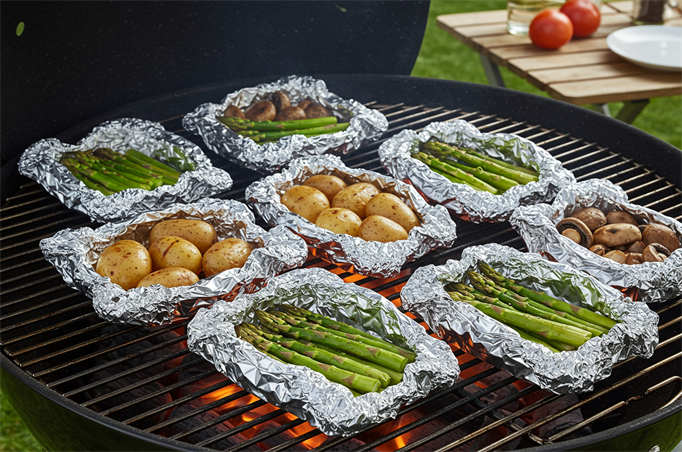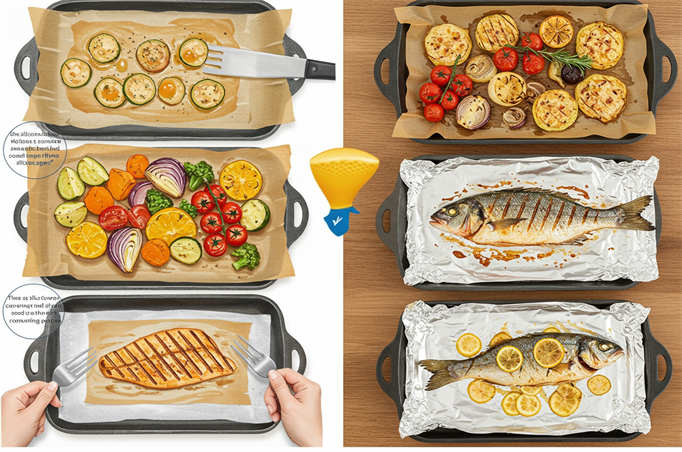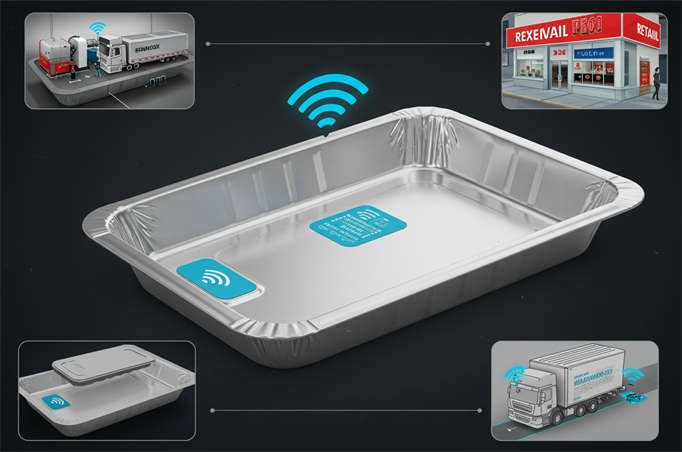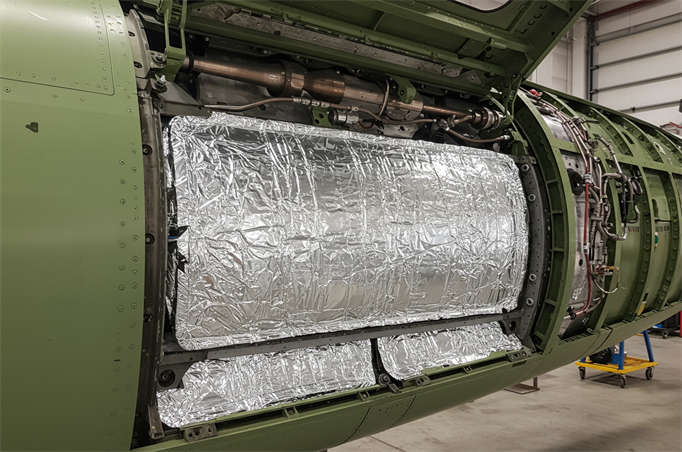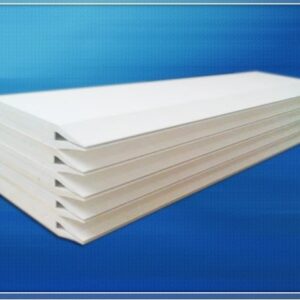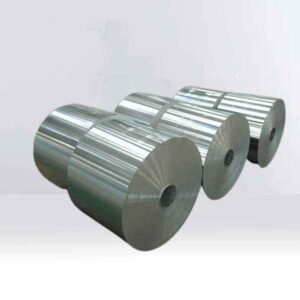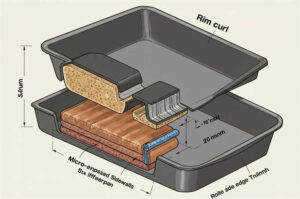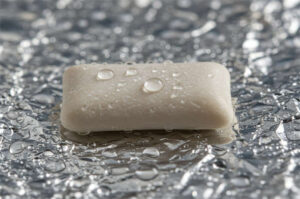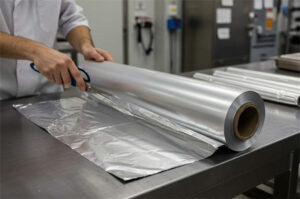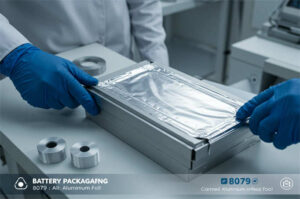Welcome to Yutwin Aluminum Foil, your trusted partner in high-quality aluminum foil solutions for everyday and industrial applications. In today’s fast-paced world, understanding the differences between materials can make all the difference in your choices—whether you’re selecting the right product for food packaging, industrial manufacturing, or household use. Today, we’re diving deep into a topic that often sparks curiosity: aluminum foil vs tin foil. While these two materials may seem interchangeable at first glance, they each have unique properties, advantages, and limitations that can impact your decision-making process. At Yutwin Aluminum Foil, we believe in empowering our customers with knowledge. Let’s explore what sets these two materials apart and why aluminum foil is superior for modern needs.
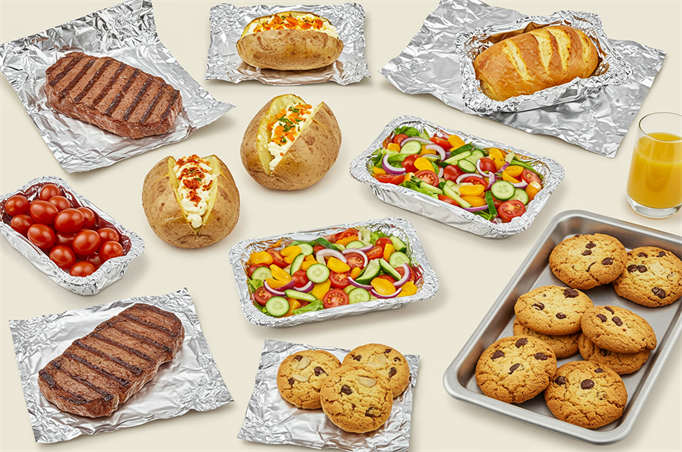
For decades, tin foil was a household staple, prized for its shiny appearance and versatility. However, its limitations—such as low melting points, brittleness, and potential toxicity—prompted the rise of aluminum foil as a safer, more durable, and cost-effective alternative. Today, aluminum foil has become the go-to material for food packaging, cooking, industrial applications, and more. But what exactly makes aluminum foil the preferred choice? Let’s break it down.
First, let’s talk about safety and health. Aluminum foil is widely recognized as safe for food contact, with minimal migration of aluminum into food under normal conditions. This makes it ideal for wrapping, cooking, and storing a wide range of foods, from meats to baked goods. On the other hand, tin foil—especially in its traditional form—can leach Tin into acidic or alkaline foods, posing potential health risks. Modern regulations and safety standards have phased mainly out tin foil in food applications, making aluminum foil the clear winner in this category.
Then there’s the matter of thermal performance. With a melting point of 660°C, aluminum foil remains stable under high heat, making it perfect for grilling, baking, and roasting. With its much lower melting point of 232°C, tin foil can’t hold up in high-temperature environments. Whether searing a steak or baking a cake, aluminum foil ensures consistent heat distribution without melting or releasing harmful substances.
But aluminium foil’s advantages don’t stop there. Its cost-effectiveness is another major factor. Aluminium is abundant, affordable, and highly recyclable, which drives down production costs and makes it accessible for everyday use. Conversely, Tin is rarer and more expensive to process, leading to higher prices for consumers. At Yutwin Aluminum Foil, we’re committed to providing high-quality products without breaking the bank, so we specialize in innovative and affordable aluminum solutions.
As we explore the differences between aluminum and Tin foil, we’ll also delve into their industrial applications, environmental impact, and versatility. Whether you’re a chef, aluminum foil manufacturer, or a curious consumer, this comparison will help you understand why aluminum foil remains the gold standard in modern material science. Stay tuned as we uncover the science, history, and practical benefits that make aluminum foil the more intelligent choice for your needs.
Aluminium and tin foil differ significantly in materials, physical characteristics, and applications. Here is a detailed analysis:
Aluminium foil vs. tin foil: Material and Physical Characteristics
Material:
- Aluminium Foil: Made from pure aluminum or aluminum alloys, it offers excellent malleability and flexibility.
- Tin Foil: Originally made from pure Tin, modern “tin foil” is aluminum foil because Tin’s low melting point and susceptibility to aging make it impractical for widespread use.
Melting Points:
- Aluminium Foil: Melts at 660°C, which is significantly higher than that of Tin.
- Tin Foil: Melts at 231.89°C, making it unsuitable for high-temperature environments.
Appearance and Durability:
- Aluminium Foil: It has a silver color, is complex, easy to cut, and usually comes in rolls.
- Tin Foil: It has a slightly bluish tint and is shinier but has lower plasticity and tends to age more quickly.
Thermal Conductivity:
- Aluminium Foil: Aluminium has excellent thermal conductivity, with a thermal conductivity of 237 W/mK.
- Tin Foil: Tin’s thermal conductivity is much lower, at 66.6 W/mK.
Aluminium foil vs tin foil: Applications
Aluminium Foil:
- Widely used for food packaging, cooking (such as grilling and baking), and cooling.
- It is also used in industrial applications like air conditioning and battery foil.
Tin Foil:
- Initially used in food packaging, it is largely replaced by aluminum foil today due to its low melting point and tendency to degrade.
- It is still used in specialized industries like electronic circuit soldering and cosmetic packaging.
Cost:
- Aluminium Foil: It is cheaper due to the low cost of aluminum and the mature production processes.
- Tin Foil: Tin is more expensive, and its production process is more complex, making tin foil costlier.
Aluminium foil has become the preferred choice in modern kitchens and industries because of its higher melting point, better thermal conductivity, and lower cost. In contrast, tin foil’s use is limited due to its melting point and aging issues.
Aluminium foil vs tin foil: Differences in Food Packaging
Aluminium and tin foil differ in food packaging regarding safety, temperature tolerance, appearance, cost, and suitability. Here’s a detailed comparison:
1. Safety
- Aluminium Foil: Aluminium foil is commonly used in food packaging and is considered safe. Aluminum migration into food is minimal and meets food safety standards. However, prolonged contact with acidic or alkaline foods may lead to some aluminum transfer, but generally, it doesn’t pose significant health risks.
- Tin Foil: Tin’s toxicity limits its use in food packaging. Tin can easily migrate in acidic or alkaline environments, and excessive tin consumption could be harmful. Therefore, tin foil is seldom used in modern food packaging, and aluminum foil is often substituted.
2. Temperature Resistance
- Aluminium Foil: With a melting point of 660°C, aluminium foil remains stable in high-temperature environments like grilling or baking without melting or releasing harmful substances.
- Tin Foil: Tin foil melts at a much lower temperature (231.89°C), which makes it unsuitable for high-temperature cooking or baking.
3. Appearance
- Aluminium Foil: Aluminium foil has a simple silver appearance, fitting the current food packaging needs.
- Tin Foil: Tin foil is shinier and has a bluish hue, but this sheen isn’t necessarily an advantage in food packaging, as it can lose its luster due to oxidation.
4. Cost
- Aluminum Foil: Aluminum is relatively inexpensive, and the production process is well-established, making aluminum foil more affordable.
- Tin Foil: Tin is costlier, and the production process is more complicated, which makes tin foil more expensive.
5. Suitability
- Aluminium Foil is commonly used for packaging meat, baked goods, frozen items, and other food products. It is suitable for both high-temperature cooking (like grilling and baking) and low-temperature storage (like freezing).
- Tin Foil: Due to stability and cost issues, the use of tin foil in food packaging has significantly decreased. It’s still used for traditional products like candy and chocolate, but aluminum foil is now preferred.
6. Plasticity and Toughness
- Aluminium Foil: Aluminium foil has better malleability and toughness, making it less likely to crack and suitable for more complex packaging designs.
- Tin Foil: Tin foil has lower plasticity and tends to age and crack more quickly, making it unsuitable for intricate packaging.
Due to its safety, temperature resistance, low cost, and better plasticity, aluminum foil has become the dominant choice for food packaging. Tin foil, with its low melting point, fragility, toxicity concerns, and higher cost, has mainly been replaced by aluminum foil in food packaging.
Aluminium foil vs. tin foil: Differences in Industrial Applications
There are apparent differences in the industrial uses of aluminum and tin foil. Here is a comparison of various application areas:
Aluminium Foil Industrial Applications:
- Food Packaging: Aluminium foil is commonly used for food packaging due to its excellent protective properties. It prevents the entry of oxygen, water, and light, which helps extend food shelf life.
- Electronics: Aluminium foil plays an essential role in electronics, and it is used in packaging, heat dissipation, and more due to its excellent conductivity and thermal properties.
- Construction: Aluminium foil is used in roofing and wall insulation materials, offering corrosion resistance and energy savings.
- Automotive: Aluminium foil is used in engine cooling systems, refrigeration units, and more to improve fuel efficiency and reduce noise.
Tin Foil Industrial Applications:
- Food Packaging: Tin foil is used for packaging items prone to corrosion, such as some chemical products, or as an insulating material for grilling.
- Electronics: Tin foil is used in capacitors’ electrodes, battery separators, and soldering in electronic components.
- Construction: Tin foil is used for moisture-proofing, heat insulation, and fire resistance.
- Medical: Tin foil is used for pharmaceutical packaging and surgical dressings. It provides protection against oxygen and moisture and has some antibacterial properties.
- Crafting: Tin foil is used for crafting, engraving, and molding due to its malleable nature and metallic luster.
Aluminium foil is favored across industries for its superior heat conductivity, high barrier properties, and low cost, while tin foil remains helpful in niche applications like electronics and crafting.
Aluminium foil vs. tin foil: Differences in Electronics Industry
The uses of aluminum foil and tin foil in electronics are distinctly different. Here’s how they compare in various applications:
Aluminium Foil in Electronics:
- Capacitor Manufacturing: Aluminium foil is a critical material for making aluminium electrolytic capacitors, both the anode and cathode foils. The anode foil undergoes electrochemical etching to create a high surface-area, porous structure that enhances capacitor performance.
- Electromagnetic Shielding: Aluminium’s excellent conductivity and shielding properties make it ideal for protecting electronic products from electromagnetic interference.
- Heat Dissipation: Aluminum foil is used in electronics heat exchangers, heat sinks, and other thermal management applications due to its high thermal conductivity.
- Cable Shielding: Aluminium foil is commonly used in conjunction with plastic to create cable shields, which provide excellent electromagnetic interference protection.
Tin Foil in Electronics:
- Capacitor Electrodes: Tin foil is used for high-end dry-type capacitors due to its good conductivity and stability.
- Battery Separators: Tin foil is used as a separator in some batteries, offering good electrical insulation and chemical resistance.
- Soldering: Tin foil is used for connecting electronic components to printed circuit boards (PCBs), providing excellent conductivity and heat transfer.
- Electromagnetic Shielding: Tin foil is also used in electronics to protect devices from electromagnetic interference.
While aluminum foil’s superior conductivity, heat dissipation, and cost efficiency make it ideal for various electronics applications, tin foil’s specific conductivity, chemical resistance, and soldering capabilities give it an edge in particular areas like capacitors and battery separators.
Cost Comparison
The cost differences between aluminium foil and tin foil mainly arise from the following factors:
Raw Material Costs:
- Aluminum: Aluminium is abundant and relatively stable in price, resulting in lower raw material costs for aluminum foil.
- Tin: Tin is rarer and subject to more price volatility, leading to higher raw material costs for tin foil.
Production Processes:
- Aluminium Foil: Aluminium foil benefits from mature production techniques, large-scale manufacturing, and strong industry capabilities, which reduce production costs.
- Tin Foil: The production process for tin foil is more complex, and its smaller-scale production results in higher costs.
Market Demand:
- Aluminum: The high demand for aluminum reduces production costs due to economies of scale.
- Tin: Tin’s lower demand and smaller market scale increase costs.
Recycling:
- Aluminum: Aluminium has a high recycling rate, and recycled aluminum can be used to produce new aluminum foil, further reducing costs.
- Tin: Tin’s recycling process is more complicated and less efficient, leading to higher costs.
In general, aluminum foil is much cheaper than tin foil due to lower raw material costs, more efficient production processes, and better recycling capabilities.
Aluminium foil vs tin foil: Durability Differences
The durability differences between aluminium foil and tin foil are notable, particularly in terms of the following:
Physical Characteristics:
- Aluminium Foil: Aluminium foil has higher strength, better tensile strength, and greater flexibility, making it more durable and capable of withstanding more strain and pressure.
- Tin Foil: Tin foil is less flexible, ages more quickly, and tends to crack easily, especially in high-temperature environments.
Heat Resistance:
- Aluminum Foil: With a melting point of 660°C, aluminum foil remains stable in high temperatures, such as grilling or baking, and doesn’t melt or release harmful substances.
- Tin Foil: Tin foil melts at just 232°C and starts to degrade above 160°C, limiting its use in high-temperature cooking.
Oxidation Resistance:
- Aluminium Foil: Aluminium foil is resistant to oxidation and doesn’t degrade quickly, making it ideal for long-term food storage and industrial applications.
- Tin Foil: Tin foil oxidizes quickly and loses its shine when exposed to air, making it unsuitable for long-term food storage.
Corrosion Resistance:
- Aluminium Foil: Aluminium has excellent corrosion resistance, even in harsh environments, ensuring its longevity in food packaging and industrial use.
- Tin Foil: Tin foil is more susceptible to corrosion, particularly in acidic or alkaline environments, reducing its performance and stability.
Recycling and Reusability:
- Aluminium Foil: Aluminium foil has a high recycling rate (over 75%), reducing production costs and making it more sustainable.
- Tin Foil: Tin foil has a low recycling rate (around 25-45%), adding to production costs.
Overall, aluminum foil outperforms tin foil in strength, heat resistance, oxidation resistance, corrosion resistance, and recyclability. Tin foil’s lower durability limits its use compared to the versatile and durable aluminum foil.
The debate between aluminum and tin foil leaves little room for doubt: aluminum is the superior choice for everyday and industrial applications. From its exceptional thermal stability and safety profile to its affordability and environmental benefits, aluminum foil outperforms tin foil in nearly every category. At Yutwin Aluminum Foil, we take pride in delivering high-quality, reliable aluminum products that meet the demands of modern life while prioritizing sustainability and innovation.
One of the most compelling advantages of aluminum foil is its versatility. Whether wrapping leftovers, lining baking trays, or insulating industrial equipment, aluminum foil adapts seamlessly to your needs. Its excellent barrier properties protect food from oxygen, moisture, and light, extending shelf life and preserving freshness. Its lightweight yet durable nature in industrial settings makes it ideal for applications ranging from electronics manufacturing to construction and automotive components. While still used in niche applications, tin foil can’t match this breadth of utility.
Another critical factor is the environmental impact. Aluminum is one of the most recyclable materials on the planet, with a recycling rate of over 75%. This reduces waste and conserves energy, as recycled aluminum requires 95% less energy to produce than raw aluminum. With its lower recycling rates and more complex processing, Tin lags in sustainability. At Yutwin Aluminum Foil, we promote eco-friendly solutions that benefit our customers and the planet.
We also can’t overlook aluminum foil’s durability. Its high melting point, resistance to corrosion, and excellent tensile strength make it suitable for long-term use in demanding environments. Tin foil, which tends to brittle and oxidize over time, is better suited for short-term applications. For businesses and households alike, the longevity of aluminum foil translates to fewer replacements and lower long-term costs.
As we reflect on the evolution of these two materials, it’s clear that aluminum foil has not only replaced tin foil in most applications but has also revolutionized industries with its exceptional properties. Whether you’re a chef looking for the perfect baking companion or an engineer seeking lightweight, high-performance materials, aluminum foil delivers results that tin foil cannot match.
At Yutwin Aluminum Foil, we’re passionate about providing solutions that combine functionality, affordability, and sustainability. Our commitment to quality and innovation ensures that our products meet the highest standards, whether you’re using them in your kitchen or factory. So the next time you reach for a roll of foil, remember its science and history—and trust that you’re making the more intelligent choice with aluminum.
Thank you for joining us on this journey of discovery. Yutwin Aluminum Foil is here to serve you with excellence and expertise for all your aluminum foil needs. Explore our range of products today and experience the difference that quality makes!

